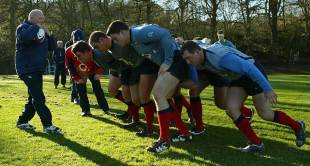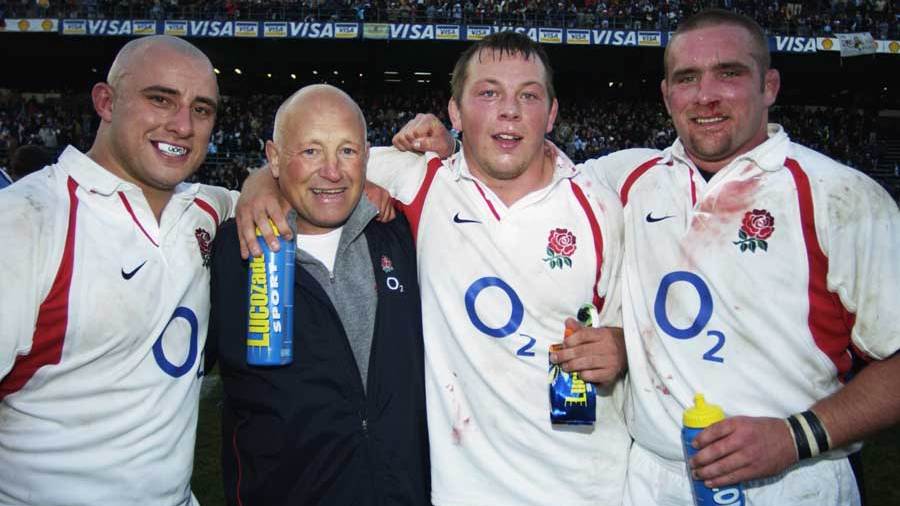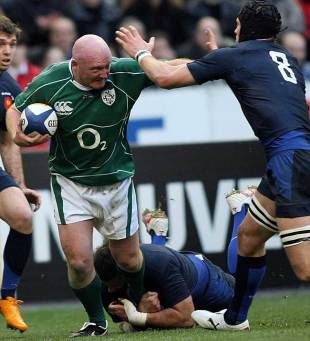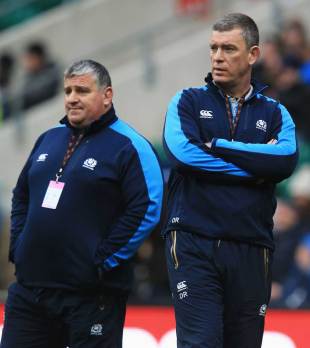|
ESPNscrum on Scrums
The coaches' view on the new scrums
Tom Hamilton
August 13, 2013

Grenoble and Bayonne contest a scrum © Getty Images
Enlarge
This weekend sees the start of the new scrum calling sequence 'crouch, bind, set' with both the Rugby Championship and the Top 14 adopting the revised method of engagement. ESPN spoke to a few coaches to gage their views on the new scrum with ex-Toulon and current Lyon coach Olivier Azam, Bristol's scrum coach Matt Ferguson, former England scrum guru Phil Keith-Roach, Grenoble forwards coach Bernard Jackman and Scotland scrum coach Massimo Cuttitta featuring.
Olivier Azam- (Ex-France hooker, former Toulon scrum coach and current Lyon forwards coach)On the player's reaction to the constant change: "I think it will make things interesting and challenging for the player. Most of the props were not happy with the way the scrum was going. For the player it's a change but in the long-term it should be a good thing because the contest will be fairer and it won't be a race into the contact. It will be more to do with power and how technical you can be. On the impact of the new scrums in the Top 14: "Any change brought in to try to improve the quality of the play, get more ball played and less penalties is a good one. Technically, the change in the new rules will take the players some time to adapt to. I think we're going to see the scrums look a bit more like the ones from the 1980s. "They will be more stable and you will see a collective unit trying to push the other side back and that will stop people jumping into the contact which was a big issue with the modern scrum. Overall it should have a good impact on the game."
Matt Ferguson- (Bristol scrum coach)On the new scrum call and club's interpretations: "There are clubs who have a strong tradition of scrummaging, like ours, and they therefore treat it highly. You take Bristol where I'm currently at, they actively went out to employ a scrum coach as it's part of their culture and therefore we spend a large part of our week doing scrum activities whether it's in the gym, the classroom or the pitch.
The guide to the new scrum by Bristol's scrum coach Matt Ferguson
"It's obvious in the Premiership teams also have that mindset. If you don't invest into any part of the game it's likely to be weaker. There's still enough for a scrum coach or forwards coach to get their teeth into." On whether the new calling sequence will see a change in the shape of props: "No not at all. If you go back to successful scrums or successful scrummagers, there tends to be three things they have in common. One, they invest in their set-ups so they are balanced and squad. Two, they have a very good ability to regain their shape if it is lost. And thirdly, that they play within the laws. "You can take Adam Jones, who is one shape, one size, and you can take Andrew Sheridan who is potentially at the other end of the scale with Gethin Jenkins or Dan Cole in between. Currently there are different shapes and sizes that play in the front-row, that's what happens at the moment. "I don't think that's going to change. What you may find is that we go back to having people that have some sort of technical knowledge of how you manipulate a scrum, rather than just big guys being very quick across the gap at the set to use force to move things from there. That's the difference."
Phil Keith-Roach- (England's World Cup-winning scrum coach)On the new scrum call: "At this stage I'm, personally, very hopeful it will lead to what they want which is more stability on engagement and hopefully they have emphasised that they want the scrums to be square and stationary on engagement and that they want the ball to be put in straight. Now if they manage to achieve those things, it will be a step forward. "But I think it will be the first time in the recent law changes that the IRB has been really clear about wanting the scrum to be a two-part process. One you engage the scrum then the referee checks it's square and stationary. And part two, the contest starts in earnest at the put-in. And it will be far easier to judge if the put-in is straight if the scrum is square and stationary. It will also take a degree of the heat out of the engagement. So I'm hopeful."

© Getty Images
Enlarge
On the change to 'crouch, touch, pause, engage' in 2007: "I think they missed the point. Over the last 10 years the scrum has been evolving of its own accord to the hit. Back in the early 90s, the scrum was a two-part process, hence there were far less collapses and jumping the gun. And then we all tried to take advantage of each other and the All Blacks started it in 1996 when they had a great front-row. They got the half-back Marshall to put the ball in almost at contact and then just drive through the hit. And obviously our response was, 'we're going to do it better than you.' And the hit became the focus of the entire event. "In scrummaging over the generations, that wasn't meant to be the case. The contest was meant to start with the put-in. And it seems the IRB is trying to get the best of the old and the best of the new. Did I think the old four-part process was questionable? I certainly did. There was no emphasis from the IRB on the scrum having to be square and stationary." On what type of player will benefit from the new calls: "It will benefit the best props, without question. The opposition has been able to negate superior power by on contact going straight to ground. By doing that, in other words collapsing deliberately, on contact, it is very hard for the referee to decide whose fault it is. I think those weaker props will have to bind up and wait for the ball to be put in. They will have to adopt a more stable and secure scrummaging position but it will also make them more vulnerable. "The stronger, better-scrummaging props will gain by this because the thing will be off the ground, the front-rows will be off the ground, the superior more technically sufficient props will be able to come out on top. They will be able to show their worth without their opposite number diving on to the ground and saying it wasn't their fault."

England's David Flatman, Phil Vickery and Steve Thompson celebrate with Phil Keith-Roach © Getty Images
Enlarge
Bernard Jackman- (Ex-Ireland and Leinster hooker, current Grenoble assistant coach)On the new scrums in pre-season matches: "We're quite happy to be honest. There have been a lot less penalties, free-kicks and scrum collapses on the hit. We've found the game is generally more efficient. And from that point-of-view it's a positive. For the non-scrum fans, the ball will be in play for longer. You can still win penalties from the scrum. If anything it's more of a contest as the teams who are weaker cannot cheat as much on the hit. They cannot counter-attack the inevitable force that will come from a bigger pack.

On the charge for Ireland
© PA Photos
Enlarge
"It will reward dominant scrums. Smaller more compact props can now survive the big powerful props. Speaking to our players, the scrums take more out of you now. In the old rules you can hit and the ball would be in and out more quickly but now the scrums will last longer with the referee having to be happy. It's more challenging on the prop's legs as this is just constant, constant pressure. The team who can get their 16-feet combining in unison will see the scrum go forward. "Everyone's starting from scratch again. We played against Montpellier last week and Nicolas Mas, one of the best tight-heads in Europe, really struggled. I'm not saying the guys who were dominant with the old rules won't find the right solution to the problem, but everyone's starting from scratch." On the role of the hooker in the new scrums: "The referees have been very vigilant over the ball being put in straight. We played around with it in training with live scrums and as soon as the hooker lifts the foot to strike, generally the defensive team move forward. In the games, we've found we've been able to strike and if the hooker really uses his right shoulder and keeps the pressure true in his body while he strikes the ball and then replaces it again, we haven't moved backwards."
Massimo Cuttitta- (Scotland scrum coach)On the new scrum calling sequence: "I think we're going to have a lot of problems at the beginning mainly for the referees and not for the players. The hit has gone but I think we'll see more collapsed scrums at the beginning. Scrums have to be a lot more technical than before but it's probably a good thing. Props have to be really technical now."

Scotland scrum coach Massimo Cuttitta alongside Dean Ryan
© Getty Images
Enlarge
On the referees potentially struggling: "I think players will find new ways of cheating. They will find ways of contrasting other scrums. You have to have a good knowledge of scrummaging with the new system. And if you don't have that they will be in a lot of trouble. I don't think it will help the referees a lot but it will make the scrums better technically. A lot of people will have good technical scrums otherwise, you'll get killed. "Referees will need time to adapt to the new laws. We all need to have a lot of patience and we need to give it a try. I'm not negative about it. I'd say we're going back to when I used to play. We were allowed to hit in the scrums but we were not allowed to push until the ball was in. We had to be very collective as a unit and I think we're going back to that." On building the relationship between coaches and referees: "I think we should work together to find solutions and to tell them what can happen - what a loose-head or a tight-head can do. At the moment with the new laws, you have to bind. You have taken the hit away from the tight-head so they don't have any weapons to help themselves. The only weapon they will have is to be technical. Loose-heads are already binding on the tight-head and that's a big bonus. In the old laws, the loose-heads would not bind and the scrum would collapse. I say things are now easier for the loose-heads."
© ESPN Sports Media Ltd Tom Hamilton is the Assistant Editor of ESPNscrum.
|
Live Sports
Communication error please reload the page.
-
Football
-
Cricket
-
Rugby
-
- Days
- Hrs
- Mins
- Secs
F1 - Abu Dhabi GP
Abu Dhabi Grand Prix December 11-131. Max Verstappen ()
2. Valtteri Bottas (Mercedes)
3. Lewis Hamilton (Mercedes)
4. Alexander Albon ()
5. Lando Norris ()
6. Carlos Sainz Jr ()
-
ESPNOtherLive >>
Darts - Premier League
Golf - Houston Open
Snooker - China Open
Tennis - Miami Open

